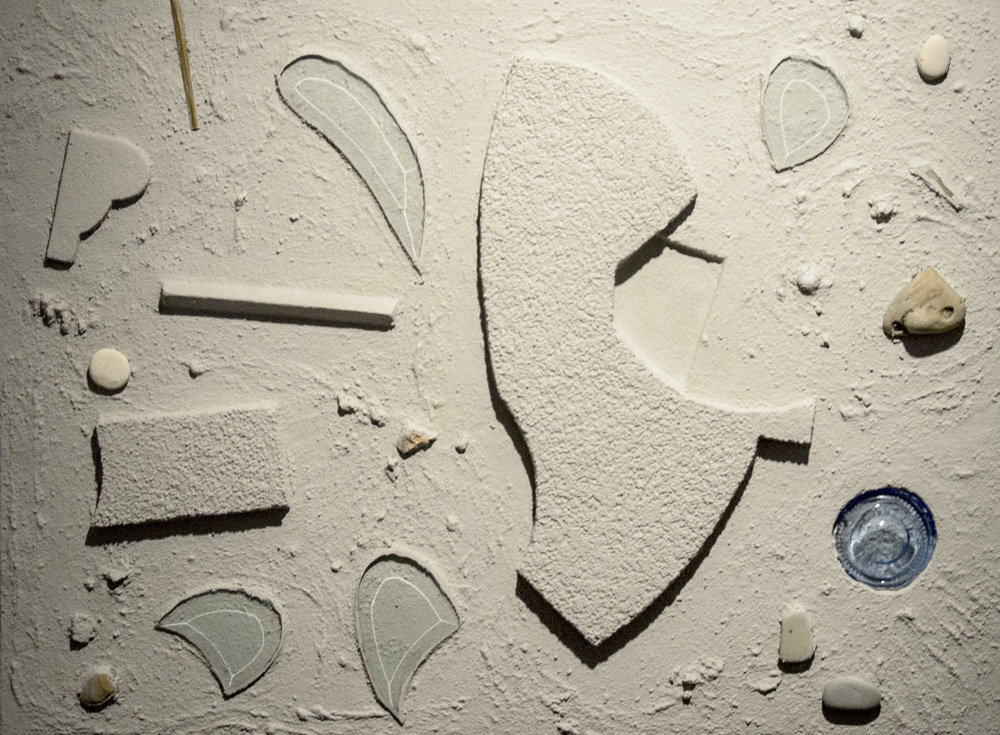In the last hot days of summer, Paul Petro Contemporary Art gallery brought to us a double exhibition of new works by Shelagh Keeley and Morley Shayuk, coherent in their highly tactile aesthetic, and yet split in references by a millennium.
 Installation view of Morley Shayuk’s work
Installation view of Morley Shayuk’s work
Morley Shayuk chose the enigmatic title of his series, Lotus, for its double reference to the mythological flower and the sports car, which highlights the ambiguousness of this “go-to spirit word”. His primary source of inspiration lies in the constructed landscape that surrounds him. Having recently moved to the suburbs of Toronto, a typical car community with houses built in the 40s and now extensively renovated, Morley became increasingly fascinated by the “bevel cluster” on front doors of neighbourhood houses.
 Detail of Morley Shayuk’s Untitled, 2014 diptych, acrylic, stuccoed cement, plastic, glass.
Detail of Morley Shayuk’s Untitled, 2014 diptych, acrylic, stuccoed cement, plastic, glass.
 Morley Shayuk, Untitled 2014, acrylic, stuccoed cement, glass, rocks.
Morley Shayuk, Untitled 2014, acrylic, stuccoed cement, glass, rocks.
The structural aesthetic of these shapes and textures – from the ubiquitous garage door to the standard v-cut on facades – directly informs his works, in which he uses an array of organic and non-organic materials: cement, glass, plastic, but also rocks and wood. By reproducing the composition, Morley has even “renovated” a painting by Toronto artist Jay Isaac, whom he admires. Motivated by the manmade, the pristine geometric compositions of Morley’s works transform the mundane and take it to the realm of pure aestheticism.
 Installation view of Shelagh Keeley’s work
Installation view of Shelagh Keeley’s work
Shelagh Keeley’s work, on the other hand, draws on the legacy of Roman culture, and specifically Lucretius’s De rerum natura (On the Nature of Things). Having previously been engaged with non-Western cultures and Eastern philosophies, Shelagh turned to Pliny the Elder, and then to Lucretius, whom she recognizes as connected to her earlier interests. It was on Cyprus that Shelagh got inspired by Lucretius’s philosophical poem and his notion of “film”, an outer layer which all things possess, and which gets detached from a thing to eventually produce perception upon interacting with our organs of sense. This idea feeds into her interest in the power of intuition and non-verbal modes of communication, which helped her transform the verbal message of Lucretius’s poetry into visual imagery. Shelagh admires Lucretius for his stance against orthodoxy and characterizes him as a visionary because he had foreseen numerous notions which are now widely accepted, such as atomism and materialism. Furthermore, she values his writing for sensuality and poetic vividness, whose visceral quality she is transposing onto her works.
 Detail of Shelagh Keeley’s after lucretius / de rerum natura, acrylic on Mylar.
Detail of Shelagh Keeley’s after lucretius / de rerum natura, acrylic on Mylar.
Currently, Shelagh is installing her major exhibition at the Power Plant, Notes on Obsolescence, curated by Gaëtane Verna which will open to the public on September 19, 2014.
 Guest in front of Morley Shayuk’s work at the Opening Reception, September 4, 2014.
Guest in front of Morley Shayuk’s work at the Opening Reception, September 4, 2014.
Text: Elena Iourtaeva and Andrey Bilenkyy. Photo: Elena Iourtaeva
*Exhibition information: Morley Shayuk: Lotus and Shelagh Keeley: after Lucretius / de rerum natura, September 5 – October 4, 2014, Paul Petro Contemporary Art, 980 Queen St West, Toronto. Gallery hours: Wed – Sat, 11 – 5 p.m.
